Improving the Door-To-Door Customer Journey for a National Public Transport Company
Abstract
:1. Introduction
- Public transport services play a vital role in sustainability, mobility and independence.
- Accessible, door-to-door transit systems with low barriers to use benefit everyone.
- To achieve sustainability in a MaaS, improved accessibility and understanding service user perceptions are of utmost importance.
- In creating a positive door-to-door journey experience, accessibility, and accessibility to information continually come to the fore.
- Travellers’ needs are diverse, and they themselves are also diverse.
- The availability and advancement of smartphone technology in the last 25 years has facilitated MaaS, allowing it to achieve progress in the integration of the public transport door-to-door travel journey; however, MaaS as a concept is still in its relative infancy.
- To improve the whole concept of MaaS, it is important to understanding the ‘complete journey’ door to door that different public transport users experience.
- There is a scarcity of research in transport services to determine gaps and unmet customer needs that would increase accessibility and the perception of autonomy.
2. Methods
3. Results
- The top requirement is for simpler info (Figure 9).
- Travellers need more accurate info on delays, and platform numbers (Figure 9).
- All information needs to be accessible (Figure 9).
- Capacity information is quite important (Figure 9).
- Travellers need to know if there will be staff around or not (Figure 9).
- ‘Nice to have’ info includes refreshments, weather and storage info (Figure 10).
- It is possible to improve autonomy by improving the door-to-door journey, especially in the areas of accessibility, safety and the provision of accurate information (Figure 14).
- Employees are still an essential element for many customers (Figure 14).
- Improved integration with other travel modes is important (Figure 14).
4. Discussion and Implications of Results
- Understanding the ‘complete journey’ door to door that different public transport users experience.
- Determining the gaps and unmet customer needs that would increase accessibility and the perception of autonomy.
Limitations of the Study
5. Conclusions
- That it is possible to improve the door-to-door experience and at the same time improve the sense of autonomy.
- That areas highlighted for action include information, accessibility, personal security, ticketing, comfort, facilities, and anxiety.
- That, as outlined in other literature, this research reiterates the need for national transport and MaaS providers to prioritise and closely consider service users’ perspectives. We recommend co-designing a means of achieving this.
- Personal safety, which is a significant issue that has affected most travellers.
- The necessity for the transport network to be accessible, and information on its accessibility be provided on.
- The necessity for all information to be easy to understand and be fully accessible.
- The fact that travellers need much more information for decision-making and it must be accurate and timely.
Author Contributions
Funding
Institutional Review Board Statement
Informed Consent Statement
Data Availability Statement
Acknowledgments
Conflicts of Interest
References
- European Commission. Sustainable Transport. 2022. Available online: https://transport.ec.europa.eu/transport-themes/sustainable-transport_en (accessed on 2 February 2024).
- European Parliament. Social Inclusion in EU Public Transport, Completed in March 2015 ed.; EDC collection; European Parliament: Strasbourg, France, 2015. [Google Scholar] [CrossRef]
- Alyavina, E.; Nikitas, A.; Tchouamou Njoya, E. Mobility as a service and sustainable travel behaviour: A thematic analysis study. Transp. Res. Part F Traffic Psychol. Behav. 2020, 73, 362–381. [Google Scholar] [CrossRef]
- Doyle, M.; Gilbert, A.; Morgan, H. Future of Transport: User Study; NatCen Social Research: London, UK, 2020. Available online: https://assets.publishing.service.gov.uk/media/5fbd16e2e90e077ee32ea0cd/Future-of-Transport-User-Study-accessible.pdf (accessed on 4 February 2024).
- Lyons, G.; Hammond, P.; Mackay, K. The importance of user perspective in the evolution of MaaS. Transp. Res. Part A Policy Pract. 2019, 121, 22–36. [Google Scholar] [CrossRef]
- Enoch, M.; Potter, S. MaaS (Mobility as a Service) market futures explored. Transp. Policy 2023, 134, 31–40. [Google Scholar] [CrossRef]
- Witlox, F.; Zwanikken, T.; Jehee, L.; Donners, B.; Veeneman, W. Changing tracks: Identifying and tackling bottlenecks in European rail passenger transport. Eur. Transp. Res. Rev. 2022, 14, 7. [Google Scholar] [CrossRef] [PubMed]
- Ingvardson, J.B.; Nielsen, O.A. How urban density, network topology and socio-economy influence public transport ridership: Empirical evidence from 48 European metropolitan areas. J. Transp. Geogr. 2018, 72, 50–63. [Google Scholar] [CrossRef]
- Yu, C.; Dong, W.; Liu, Y.; Yang, C.; Yuan, Q. Rethinking bus ridership dynamics: Examining nonlinear effects of determinants on bus ridership changes using city-level panel data from 2010 to 2019. Transp. Policy 2024, 151, 85–100. [Google Scholar] [CrossRef]
- Yang, C.; Yu, C.; Dong, W.; Yuan, Q. Substitutes or complements? Examining effects of urban rail transit on bus ridership using longitudinal city-level data. Transp. Res. Part A Policy Pract. 2023, 174, 103728. [Google Scholar] [CrossRef]
- Dong, X. Investigating changes in longitudinal associations between declining bus ridership, bus service, and neighborhood characteristics. J. Public Transp. 2022, 24, 100011. [Google Scholar] [CrossRef]
- Stjernborg, V. Accessibility for All in Public Transport and the Overlooked (Social) Dimension—A Case Study of Stockholm. Sustainability 2019, 11, 4902. [Google Scholar] [CrossRef]
- EN 17161:2019; Design for All. Accessibility Following a Design for All Approach in Products, Goods and Services. NSAI: Dublin, Ireland, 2019.
- Susilo, Y.O.; Cats, O. Exploring key determinants of travel satisfaction for multi-modal trips by different traveler groups. Transp. Res. Part A Policy Pract. 2014, 67, 366–380. [Google Scholar] [CrossRef]
- Friman, M.; Lättman, K.; Olsson, L.E. Public Transport Quality, Safety, and Perceived Accessibility. Sustainability 2020, 12, 3563. [Google Scholar] [CrossRef]
- Balcombe, R.; Mackett, R.; Paulley, N.; Preston, J.; Shires, J.; Titheridge, H.; Wardman, M.; White, P. The Demand for Public Transport: A Practical Guide. 2004. Available online: https://discovery.ucl.ac.uk/id/eprint/1349/1/2004_42.pdf (accessed on 20 March 2024).
- Stradling, S.; Hine, J.; Wardman, M. Physical, cognitive and affective effort in travel mode choices. In Proceedings of the International Conference On Traffic And Transport Psychology-ICTTP, Berne, Switzerland, 4–7 September 2000. [Google Scholar]
- Cluett, C.; Bregman, S.; Richman, J. Customer Preferences for Transit ATIS: Research Report; Federal Transit Administration: Washington, DC, USA, 2003. Available online: https://rosap.ntl.bts.gov/view/dot/4138 (accessed on 22 April 2024).
- Kenyon, S.; Rafferty, J.; Lyons, G. Social Exclusion and Transport in the UK: A Role for Virtual Accessibility in the Alleviation of Mobility-Related Social Exclusion? J. Soc. Policy 2003, 32, 317–338. [Google Scholar] [CrossRef]
- Hine, J.; Scott, J. Seamless, accessible travel: Users’ views of the public transport journey and interchange. Transp. Policy 2000, 7, 217–226. [Google Scholar] [CrossRef]
- Myerson, J. Ideo: Masters of Innovation; Laurence King: Hachette, UK, 2001. [Google Scholar]
- Torabi, K.F.; Araghi, Y.; van Oort, N.; Hoogendoorn, S. Passengers preferences for using emerging modes as first/last mile transport to and from a multimodal hub case study Delft Campus railway station. Case Stud. Transp. Policy 2022, 10, 300–314. [Google Scholar] [CrossRef]
- Brown, T. Change by Design—How Design Thinking Transforms Organizations and Inspires Innovation; Harper Collins: New York, NY, USA, 2009. [Google Scholar]
- Woodcock, A.; Tovey, M. Designing Whole Journey, Multimodal Transport Provision. Des. J. 2020, 23, 91–112. [Google Scholar] [CrossRef]
- Tovey, M.; Woodcock, A.; Osmond, J. Designing Mobility and Transport Services: Developing Traveller Experience Tools; Taylor & Francis: Abingdon, UK, 2016. [Google Scholar]
- Gosselin, K. Study Finds Access to Real-Time Mobile Information Could Raise the Status of Public Transit. 2011. Available online: https://urbantoronto.ca/forum/threads/study-finds-access-to-mobile-information-could-raise-the-status-of-public-transit.16249/ (accessed on 21 August 2024).
- Latitude Research. Tech for Transit: Designing a Future System. 2011. Available online: https://www.infrastructureusa.org/wp-content/uploads/2011/03/tech-for-transit-summary.pdf (accessed on 21 August 2024).
- Dziekan, K.; Kottenhoff, K. Dynamic at-stop real-time information displays for public transport: Effects on customers. Transp. Res. Part A Policy Pract. 2007, 41, 489–501. [Google Scholar] [CrossRef]
- Dziekan, K.; Vermeulen, A.J. The Added Value of Real-Time Information and Effects to Customer Behaviour—A before-after Study of the Implementation of a New Real-Time Information System; KTH: Stokholm, Sweden; HTM: Hague, The Netherlands, 2004. [Google Scholar]
- Rezapour, M.; Ferraro, F.R. Rail Transport Delay and Its Effects on the Perceived Importance of a Real-Time Information. Front. Psychol. 2021, 12, 619308. [Google Scholar] [CrossRef] [PubMed]
- Yajuan, D.; Mingli, C. Impacts of Real-Time Transit Information on Bus Passengers’ Travel Choices Based on Travel Behaviour Survey. Promet—Traffic Transp. 2021, 33, 539–550. [Google Scholar] [CrossRef]
- Córas Iompair Éireann (CIÉ). History of CIÉ Córas Iompair Éireann. Available online: https://www.cie.ie/en-ie/Who-we-are/History-of-CIE (accessed on 20 June 2024).
- Iarnród Éireann. Iarnród Éireann Annual Report 2022; The Route to Sustainabilty. Dublin, 2022. Available online: https://www.irishrail.ie/Admin/getmedia/aed78e9f-a811-4c3b-a8d4-7609b912e62c/22-IE-Annual-Report-English.pdf (accessed on 21 June 2024).
- Menezes, T.J.T.; Gomes, C.F.S. Pharmaceutical industrial equipment qualification in Brazil: A strategic test proposal for vaccine secondary material packaging lines. Health Technol. 2020, 10, 1181–1194. [Google Scholar] [CrossRef]
- Steen, M.; Manschot, M.; De Koning, N. Benefits of co-design in service design projects. Int. J. Des. 2011, 5, 53–60. Available online: https://www.ijdesign.org/index.php/IJDesign/article/view/890/346 (accessed on 22 January 2024).
- White, P.J.; Alders, G.; Patocs, A.; Raina, P. COVID-19 and interdisciplinary research: What are the needs of researchers on aging? Tuning J. High. Educ. 2021, 9, 239–263. [Google Scholar] [CrossRef]
- Zallio, M.; Grey, T.; Boland, P.; Kelly, H.; White, P.J.; O’Ferrall, E. Online - based participatory design. A Case Study of Developing International Standards During a Pandemic. Strateg. Des. Res. J. 2022, 15, 39–51. [Google Scholar] [CrossRef]
- McKercher, K.A. Beyond Sticky Notes: Co-Design for Real: Mindsets, Methods and Movements; Beyond Sticky Notes; Inscope Books: Cammeraygal Country, Australia, 2020. [Google Scholar]
- Bell, J.; Waters, S. Doing Your Research Project: A Guide for First Time Researchers, 7th ed.; McGraw-Hill Education: New York, NY, USA, 2018. [Google Scholar]
- Tesch, R. Qualitative Research: Analysis Types and Software Tools; Falmer Press: London, UK, 1990. [Google Scholar]
- White, P.J.; Devitt, F. Creating Personas from Design Ethnography and Grounded Theory. J. Usability Stud. 2021, 16. Available online: https://uxpajournal.org/personas-ethnography-grounded-theory/ (accessed on 3 May 2024).
- White, P.J.; Devitt, F. The Design and Development of Novel Cooking and Heating Products for Irish Older Adults- a Real Health Need. Des. Princ. Pract. Int. J. 2011, 5, 13. [Google Scholar] [CrossRef]
- Creswell, J.W.; Creswell, J.D. Research Design: Qualitative, Quantitative, and Mixed Methods Approaches; SAGE: Los Angeles, CA, USA, 2018. [Google Scholar]
- White, P.J.; Okello, D.; Casey, B.P.; Najjuuko, C.; Lukanga, R. Co-designing with engineers for community engagement in rural Uganda. Des. Sci. 2023, 9, e12. [Google Scholar] [CrossRef]
- White, P.J.; Casey, B.P.; Cleary, O.; Finn, E.; O’Connor, K.; Coen, N. Co-design with Integrated Care Teams: Establishing Information Needs. Int. J. Integr. Care 2023, 23, 7. [Google Scholar] [CrossRef]
- Gaynor, L.; Dempsey, H.; White, P.J. How Design Thinking Offers Strategic Value to Micro-Enterprises. In Proceedings of the Design as a Catalyst for Change—DRS International Conference, Limerick, Ireland, 25–28 June 2018; Storni, C., Leahy, K., McMahon, M., Lloyd, P., Bohemia, E., Eds.; Design Research Society: London, UK, 2018; Volume 7, pp. 2974–2986. [Google Scholar] [CrossRef]


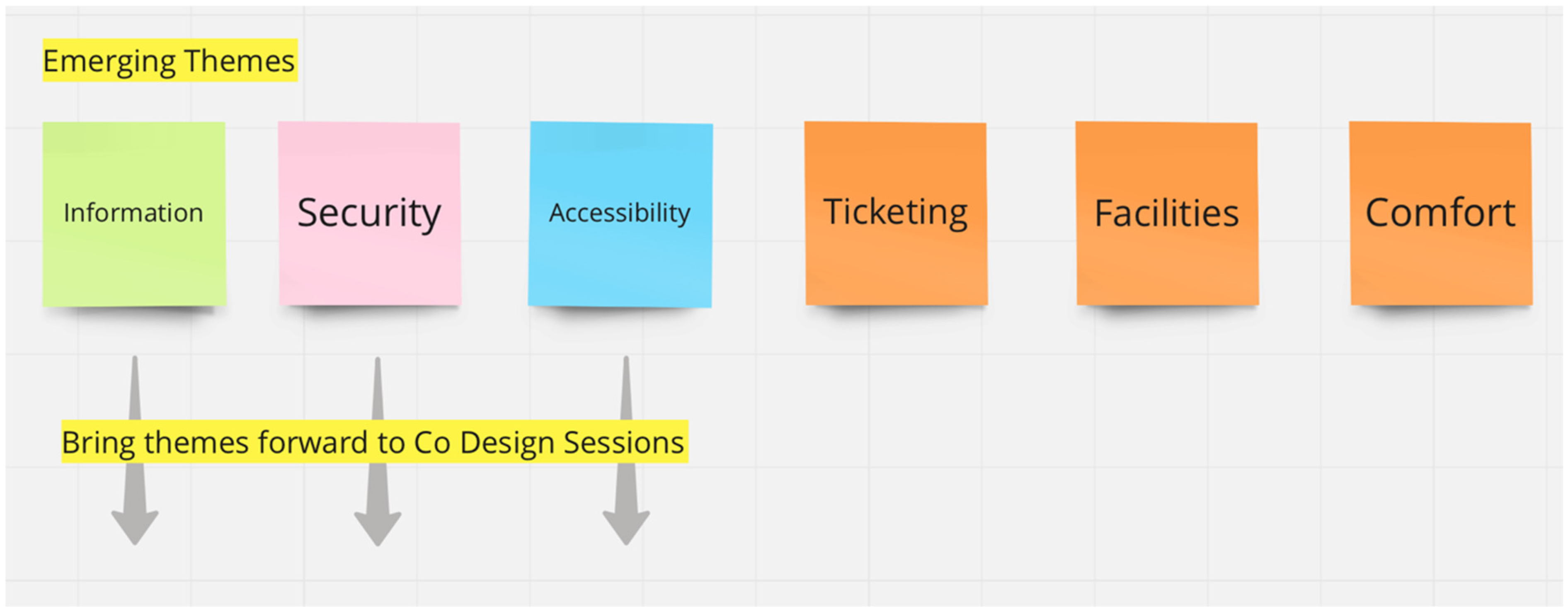
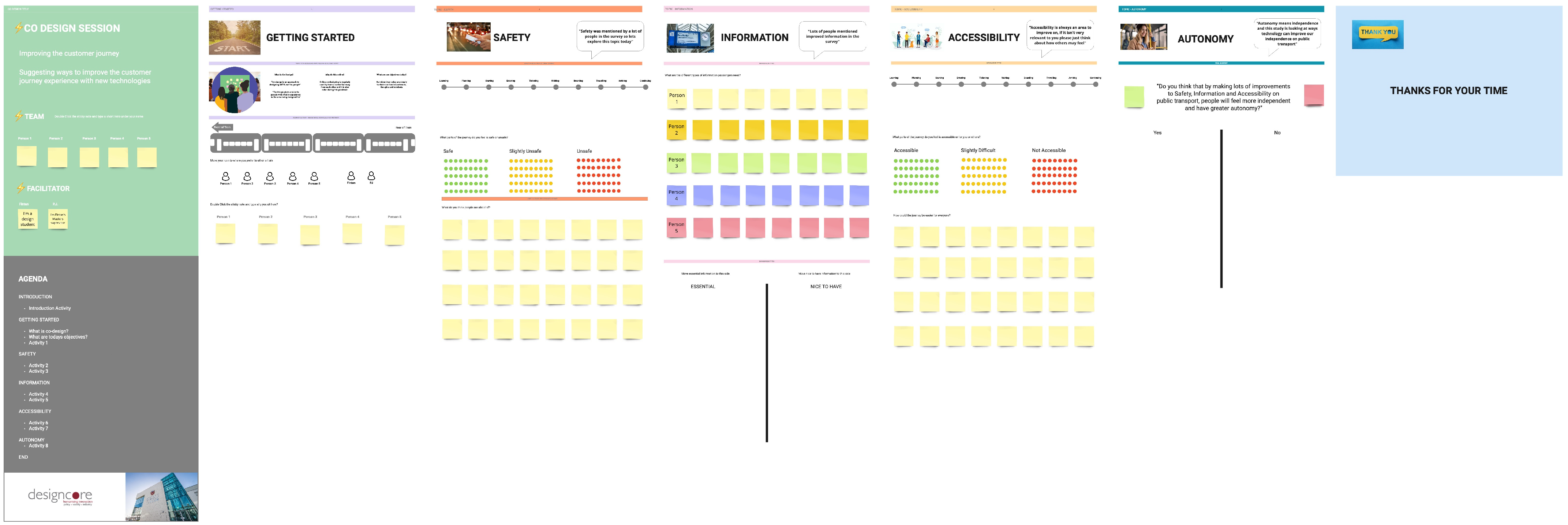



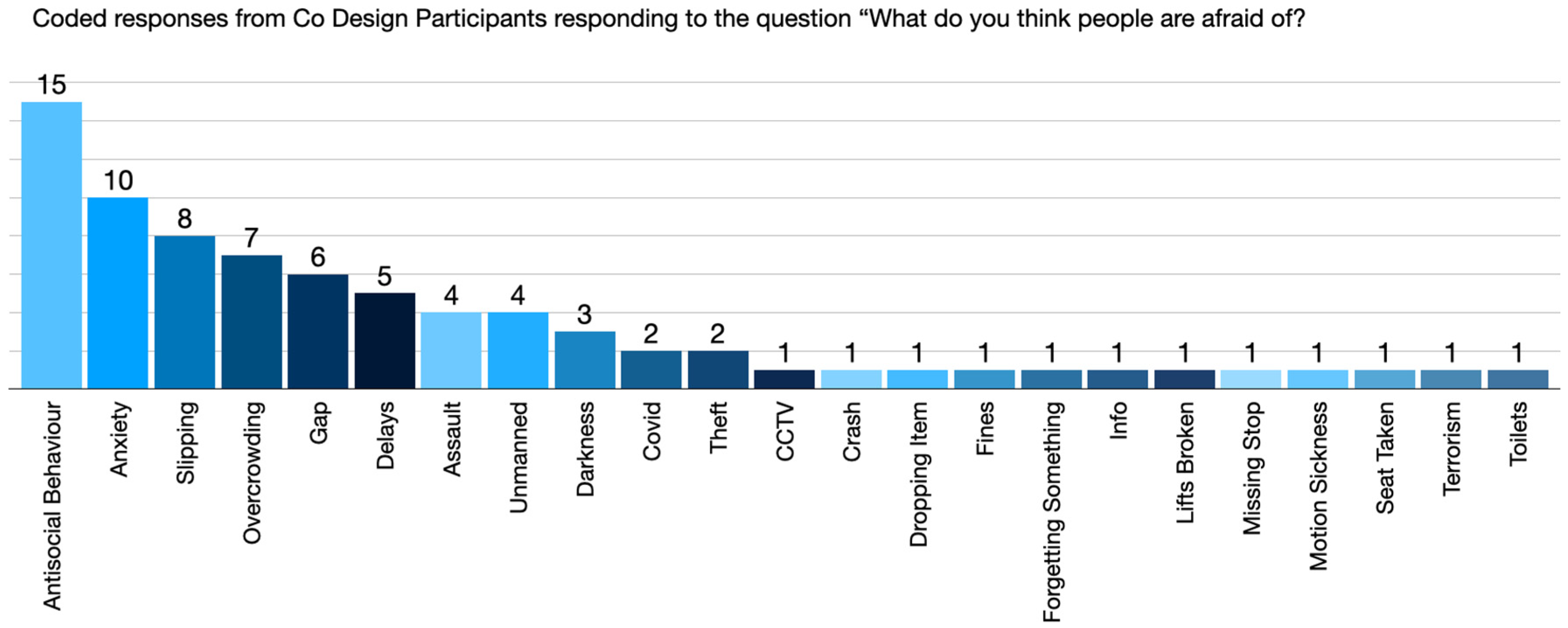




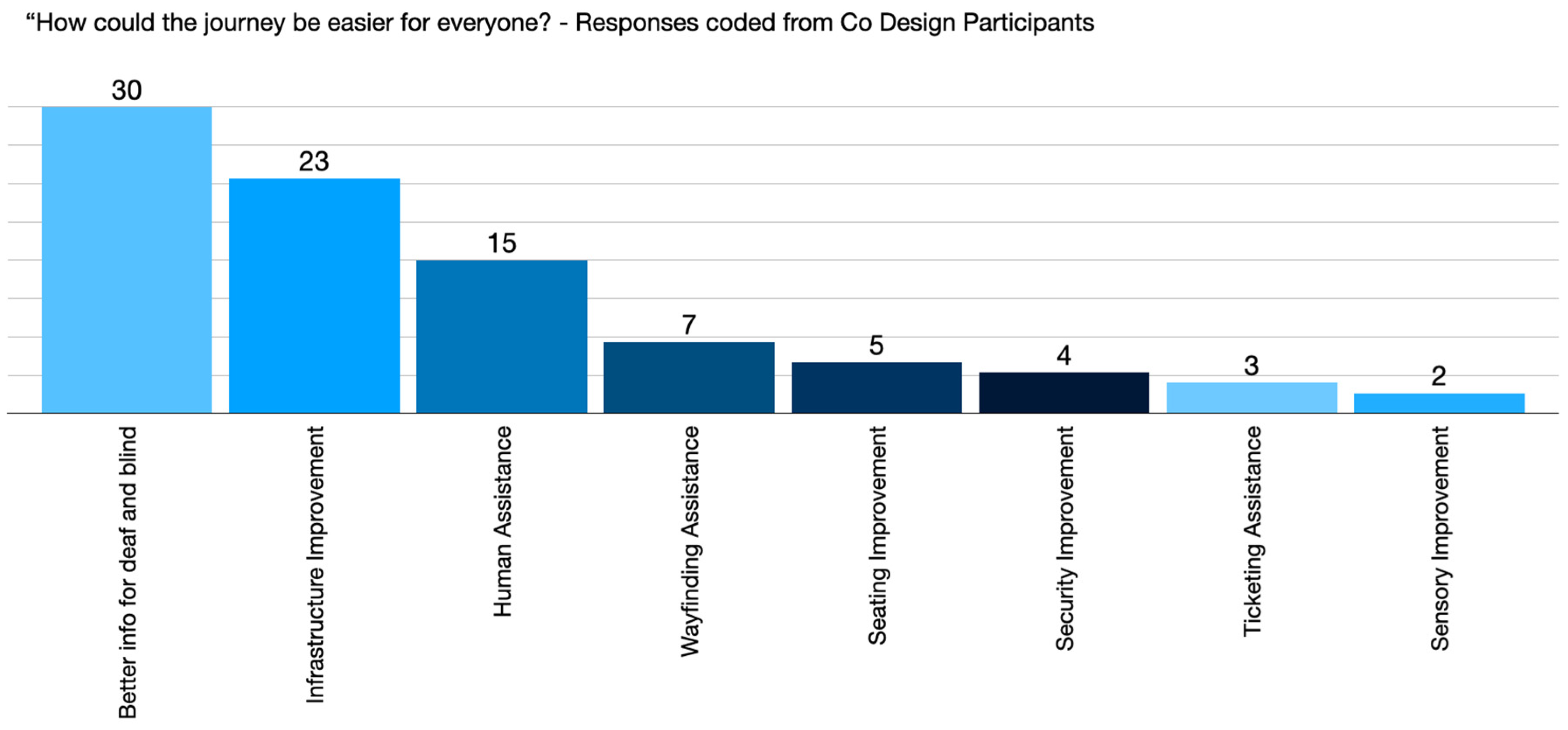
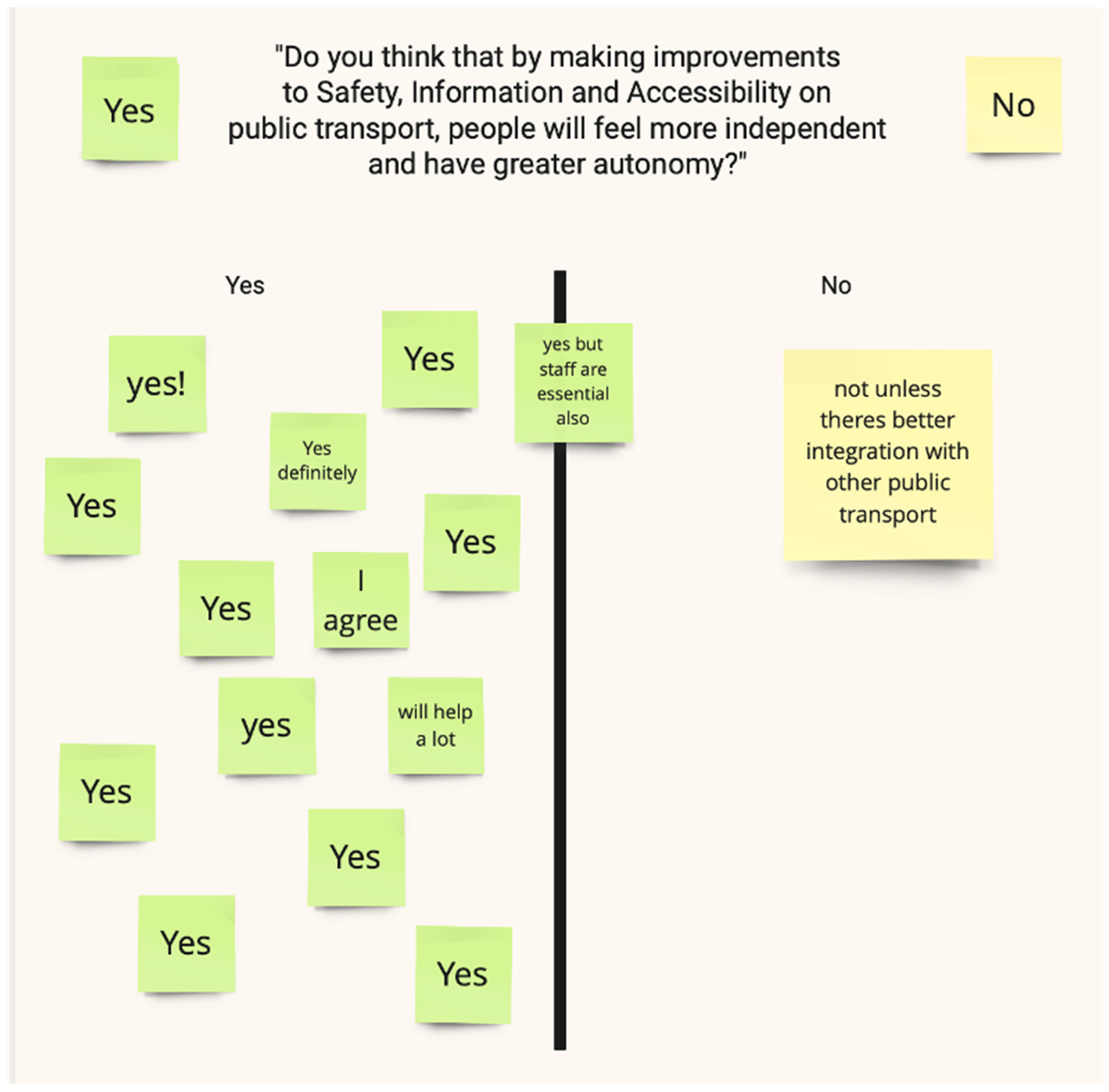
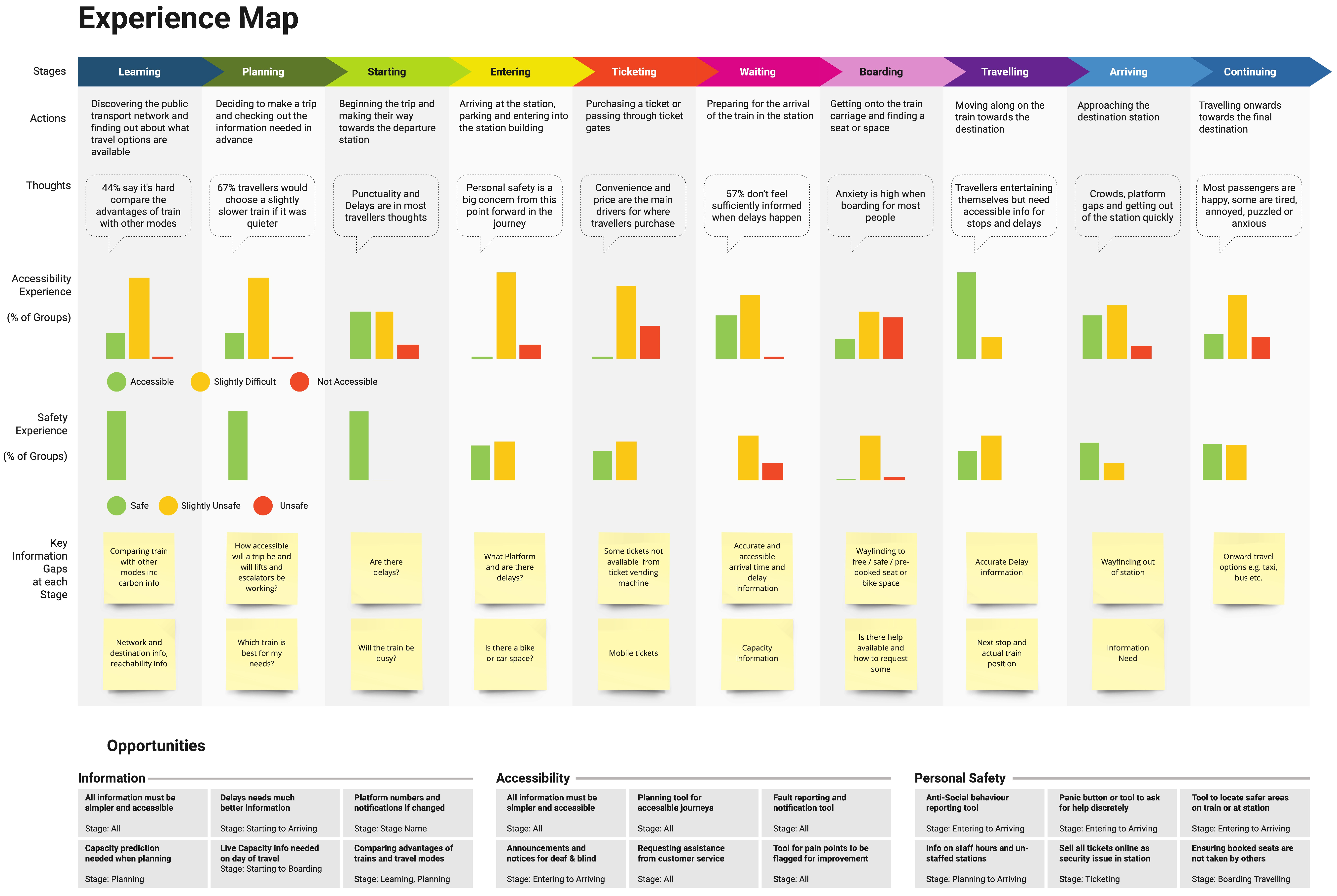
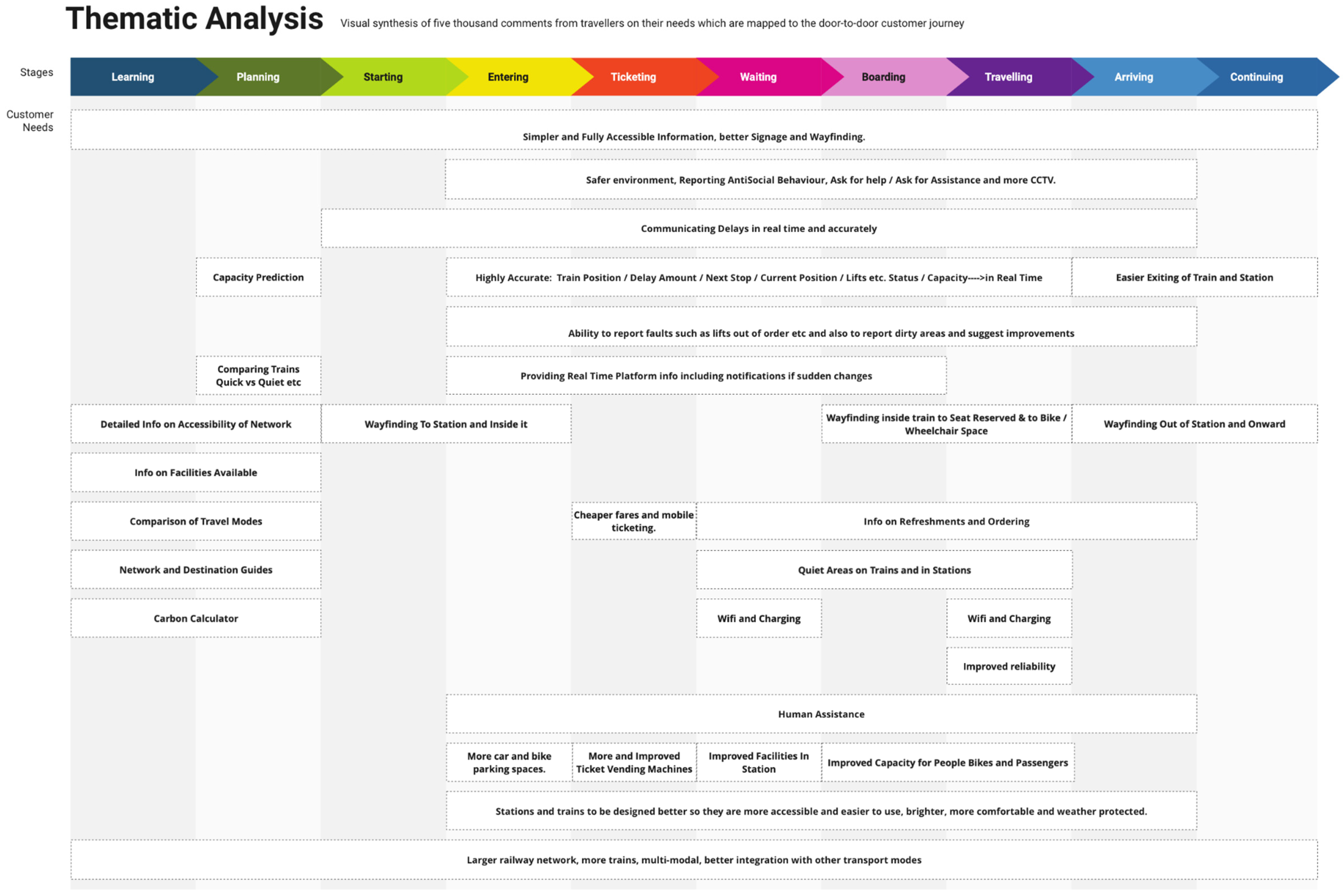
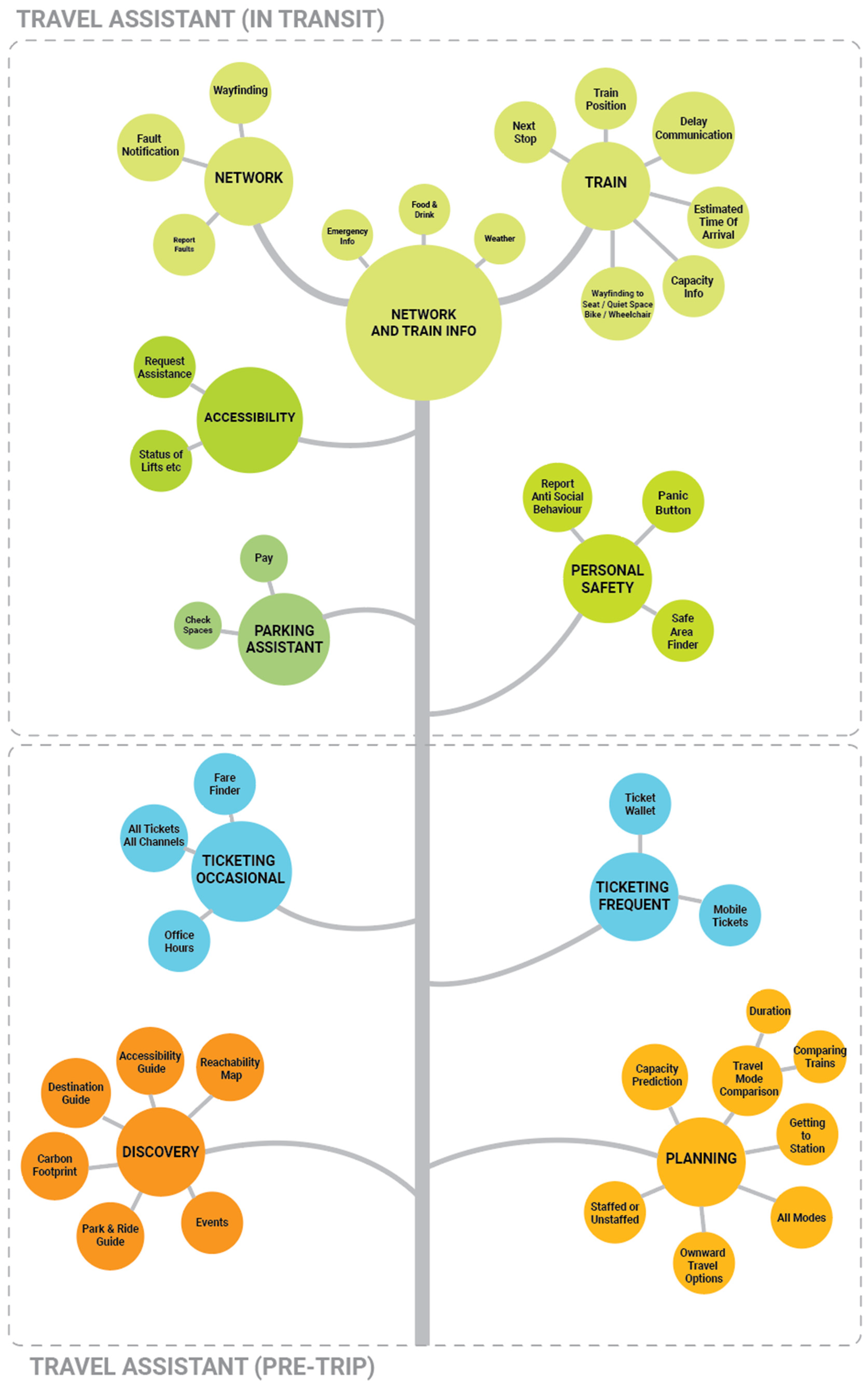
| Participant | Gender | Traveller Type | Disability |
|---|---|---|---|
| A | Male | Non-Frequent | No |
| B | Male | Frequent | Yes |
| C | Female | Frequent | No |
| D | Male | Non-Frequent | No |
| E | Male | Frequent | No |
| F | Female | Non-Frequent | No |
| G | Male | Non-Frequent | Yes |
| H | Female | Non-Frequent | No |
| I | Female | Frequent | No |
| J | Male | Frequent | No |
| K | Male | Non-Frequent | No |
| L | Female | Frequent | Yes |
| M | Male | Non-Frequent | Yes |
| N | Male | Frequent | No |
| Summary | Male = 9 Female = 5 | Frequent = 7 Non-Frequent = 7 | Yes = 4 No = 10 |
| Quantitative Questions | Qualitative Questions | |
|---|---|---|
| Learning | Generally speaking, do you think most people in Ireland know about Irish Rail? | |
| Do you think information on Irish Rail is easily obtained? | ||
| Do you think it is easy to compare advantages or disadvantages of train travel with other modes of travel? | ||
| Planning | How do you find out about train timetables and prices? Tick all that apply. | |
| When planning a new trip, do you check if there is a train service near your destination? | ||
| Starting | Do you feel that you have all the information that you need before setting out? | Can you briefly describe what is on your mind when setting out on a journey? |
| Entering | When you arrive at the station, is it easy to access and navigate? | What is on your mind when entering the station. |
| Is it easy to park your bike, scooter, car etc.? | ||
| Ticketing | How do you usually purchase your ticket? | Why did you choose this method? (Purchasing ticket) |
| Do you find purchasing tickets easy? | ||
| Waiting | Is your safety and security a concern as you wait? | What is on your mind when waiting for the train to arrive? |
| How do you keep informed about the train as you wait? | Is there anything that would make waiting in the station better for you? | |
| Boarding | Do you feel confident when boarding? | As your train arrives what is on your mind? |
| Is there anything that would make boarding easier for you? | ||
| Travelling | Is your safety and security a concern while travelling? | What is on your mind as you travel? |
| If delays occur, do you feel sufficiently informed? | Is there anything that would make travelling more enjoyable? | |
| If train A was slightly quicker but very busy and train B was slightly slower but very quiet, generally speaking which would you take? | ||
| Arriving | What is on your mind as you near the end of the train trip? | |
| Continuing | Typically, what are your next steps? Tick all that apply. | What is on your mind as you arrive at your final destination? |
| Research Question | Generally speaking, do you feel sufficiently independent in your mobility options and freedom to travel? | Is there anything that would improve your general mobility and freedom? |
| Are you comfortable using smartphone and apps? | ||
| Which of the following often feature in your door to door trip? Tick all that apply. | ||
| Accessibility | Do you have any physical restrictions with regard to your mobility on public transport? | |
| Do you encounter any sensory or communication restrictions when using public transport? | ||
| Customer Satisfaction | Generally speaking, are you satisfied with your whole journey? | |
| Data Quality | How often would you make trips on Irish Rail (in normal times pre COVID)? |
| Benefits for the Project | Benefits for the Users | Benefits for the Organization | |
|---|---|---|---|
| Improving Idea Generation | Better ideas, better knowledge about customers’ needs. | Improved creativity and focus on customers. Improved interdisciplinary cooperation. | |
| Improving the service | Improved service definition, higher quality and more successful innovations. | Better fit of service and needs, contributing to a better experience and higher quality. | |
| Improving Project Management | Better project management, decision making, lower development cost, reduced development time and continuous improvement. | ||
| Improving longer term effects | Higher satisfaction, loyalty and more educated users. | More successful innovation and more support for change. Improved relationships and public relations. |
| Theme | Key Insights |
|---|---|
| Information | When delays happen, 57% do not feel sufficiently informed. The majority of travellers (57%) feel it is difficult to compare the advantages of train travel with other modes of travel. When planning a new trip, 24% of travellers do not check if there is a train service serving it. Fourteen percent of travellers do not have all the information they need before setting out to travel. |
| Accessibility | Six percent of travellers do not feel independent enough. Four percent have some physical restrictions on their mobility to travel on public transport. Ten percent of travellers encounter sensory or communication restrictions when travelling on public transport. At the station, 14% do not find it easy to access and navigate it. Accessibility is a concern for travellers at all stages of the complete customer journey. |
| Personal Security | Fifty-five percent have experienced safety and security concerns. Personal safety is a concern at all stages of the complete customer journey. While the train is in motion, 47% of travellers continue to be concerned with safety and security. |
| Ticketing | Close to one-fifth of people purchase their tickets offline. The decision of whether to buy online/ticket office/ticket machine, etc., is mainly influenced by the perceived convenience and the cheapest price. |
| Comfort | Sixty-seven percent of travellers might prefer a quieter train even if it is slower. |
| Facilities | Almost half the travellers that need to park (car, bike, scooter) find it difficult. |
| Anxiety | As the train arrives, there are several things in the mind of travellers that may give rise to anxiety, such as lateness, getting a seat, their safety, if they are on the correct train, and if they will be able to get on safely. As the train arrives at the destination, there are many thoughts that can give rise to anxiety, e.g., getting off, personal belongings, unruly passengers, making connections, getting out of the station, etc. |
| Description of User Need | Primary Stakeholders | Potential IT Solution |
|---|---|---|
| Network and destination guides | Irish Rail | Yes |
| Reporting anti-social behaviour and calling for help | Irish Rail/Gardai (Irish Police) | Yes |
| Better integration with other travel modes | Irish Rail/National Transport Authority | Partially |
| Carbon calculator | Irish Rail | Yes |
| Communicating delays in real time and accurately | Irish Rail | Yes |
| Easier exiting at end of journey | Irish Rail | Partially |
| Comparison of travel modes | Irish Rail | Yes |
| Providing real-time platform info including notifications if sudden changes | Irish Rail | Yes |
| Info on facilities available | Irish Rail | Yes |
| Quiet areas in trains and stations | Irish Rail | Partially |
| Way-finding inside train to seat reserved for bikes/wheelchair space | Irish Rail | Partially |
| Way-finding out of station and onward | Irish Rail | Yes |
| Detailed accessibility info | Irish Rail | Yes |
| Way-finding to station and inside it | Irish Rail | Partially |
| Cheaper fares and mobile ticketing. | Irish Rail/National Transport Authority | Partially |
| Improved reliability | Irish Rail | No |
| Comparing trains quick vs. quiet, etc. | Irish Rail | Yes |
| Highly accurate: train position/delay/next stop/lift status/capacity | Irish Rail | Yes |
| Capacity prediction | Irish Rail | Yes |
| More and improved ticket vending machines | Irish Rail | Partially |
| Improved capacity for people bikes and propriety passengers | Irish Rail/National Transport Authority | No |
| Improved facilities in station | Irish Rail | No |
| More car and bike parking spaces. | CIE Property/Local Authorities | No |
| Info on refreshments and ordering | Irish Rail | Yes |
| Human assistance | Irish Rail | Partially |
| Wi-Fi and charging | Irish Rail | No |
| Stations and trains to be designed better so they are more accessible and easier to use, brighter, more comfortable and weather protected. | Irish Rail | No |
| Safer environment with means to request help/assistance and more CCTV. | Irish Rail | Partially |
| Ability to report faults such as lifts out of order etc. and also to report dirty areas and suggest improvements | Irish Rail | Yes |
| Simpler and accessible information, better signage and way-finding. | Irish Rail | Yes |
| Larger railway network, more trains, multi modal. | Irish Rail/National Transport Authority | Partially |
Disclaimer/Publisher’s Note: The statements, opinions and data contained in all publications are solely those of the individual author(s) and contributor(s) and not of MDPI and/or the editor(s). MDPI and/or the editor(s) disclaim responsibility for any injury to people or property resulting from any ideas, methods, instructions or products referred to in the content. |
© 2024 by the authors. Licensee MDPI, Basel, Switzerland. This article is an open access article distributed under the terms and conditions of the Creative Commons Attribution (CC BY) license (https://creativecommons.org/licenses/by/4.0/).
Share and Cite
Kennedy, F.; White, P.J.; Dempsey, H. Improving the Door-To-Door Customer Journey for a National Public Transport Company. Sustainability 2024, 16, 8741. https://doi.org/10.3390/su16208741
Kennedy F, White PJ, Dempsey H. Improving the Door-To-Door Customer Journey for a National Public Transport Company. Sustainability. 2024; 16(20):8741. https://doi.org/10.3390/su16208741
Chicago/Turabian StyleKennedy, Fintan, P.J. White, and Hilary Dempsey. 2024. "Improving the Door-To-Door Customer Journey for a National Public Transport Company" Sustainability 16, no. 20: 8741. https://doi.org/10.3390/su16208741






